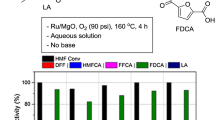Abstract
Conversion of rosin to its pentaerythritol ester provides a means of improving its water resistance, alkali resistance, and oxidation resistance, thereby increasing its stability. Rosin pentaerythritol ester is much more amenable to industrial applications than the parent compound. To overcome the difficulty of catalyst recovery and its associated high cost during the synthesis of rosin pentaerythritol ester, Fe3O4-supported ZnO catalysts, such as Fe3O4@ZnO and Fe3O4@SiO2–ZnO, have been designed and synthesized. The structures, morphologies, and compositions of the materials have been characterized by TEM, XRD, and XPS. The results of esterification reactions demonstrate that Fe3O4@SiO2–ZnO has excellent catalytic performance and stability. The degree of esterification in the production of rosin pentaerythritol ester reached 87.9%, far exceeding the yields attained with other catalysts. Moreover, the catalyst could be reused five times without incurring a loss of activity. The effects of zinc source, zinc loading, and reaction conditions on the esterification have been investigated in detail. This study provides a class of heterogeneous catalysts with excellent properties for the synthesis of rosin pentaerythritol ester.
Graphic Abstract
In our paper, the optimum process conditions for obtaining rosin pentaerythritol ester have been identified as zinc nitrate as the zinc source, a theoretical loading of zinc source of 0.45 g, a reaction temperature of 250 °C, a reaction time of 5 h, and a catalyst loading of 0.2 g, when starting from rosin (15 g) and pentaerythritol (1.7 g). The conversion rate was 87.9%, and the acid value was 25.0 mg KOH g−1. This research provides an improved protocol for the rosin esterification reaction.







Similar content being viewed by others
References
Pan K, Qin N, Huang F (2017) Research progress in catalytic esterification of rosin. Popul Sci Technol 06:46–48
Wang H, Wang H, Zhou G et al (2011) Application of rosin in polymer synthesis. Chin Polym Bull 01:51–58
Gao H, Song Z, Wang Z et al (2005) Preparation of highly stable light-colored rosin glyceride. J For Chem Ind Commun 05:1–4
Gao H, Song Z, Shang S (2008) Study on the stability of colorless rosin pentaerythritol ester. Chem Ind For Prod 28(1):44–45
Cao Z (2007) Study on preparation of catalyst by microwave intervention and promoting rosin esterification. Kunming University of Science and Technology
Hao Q, Ha C (2000) Research progress of esterification catalyzed by rosin. Chem Ind For Prod 01:80–86
Zhao Q, Wu C, Zhang J et al (2004) Study on synthesis of glycerol rosin catalyzed by nanometer zinc oxide. Chem World 09:473–477
Wang L, Ding S, Gan P et al (2016) A supported nano ZnO catalyst based on a spent fluid cracking catalyst (FC3R) for the heterogeneous esterification of rosin. React Kinet Mech Catal 119(1):1–15
Liu Y (2017) Study on preparation of magnetic nanocatalyst and catalytic hydrogenation. Qingdao University of Science and Technology
General Administration of Quality Supervision, Inspection and Quarantine of the People's Republic of China, China Standardization Management Committee (2003) Rosin test method: GB/T8146-2003. Beijing: China Standard Press, pp 2–5
General Administration of Quality Supervision, Inspection and Quarantine of the People's Republic of China, China Standardization Management Committee (2012) Food additives: glycerol rosin and glycerol hydrogenated rosin: GB10287-2012. Beijing: China Standard Press, pp 1–2
Sun L (2011) Study on preparation and properties of multifunctional Fe3O4/ZnO/SiO2 nanocomposites. Northeast Normal University
Chi Y, Yuan Q, Li Y et al (2013) Magnetically separable Fe3O4@SiO2@TiO2-Ag microspheres with well-designed nanostructure and enhanced photocatalytic activity. J Hazard Mater 262:404–411
Acknowledgements
This work was supported by the National Key Research and Development Program of China (2016YFD0600804).
Author information
Authors and Affiliations
Corresponding author
Ethics declarations
Conflict of interest
No conflict of interest between authors.
Additional information
Publisher's Note
Springer Nature remains neutral with regard to jurisdictional claims in published maps and institutional affiliations.
Electronic supplementary material
Below is the link to the electronic supplementary material.
Rights and permissions
About this article
Cite this article
Yu, S., Zhang, H. Preparation of Rosin Pentaerythritol Ester Over an Fe3O4-Supported ZnO Catalyst. Catal Lett 150, 3359–3367 (2020). https://doi.org/10.1007/s10562-020-03237-5
Received:
Accepted:
Published:
Issue Date:
DOI: https://doi.org/10.1007/s10562-020-03237-5




